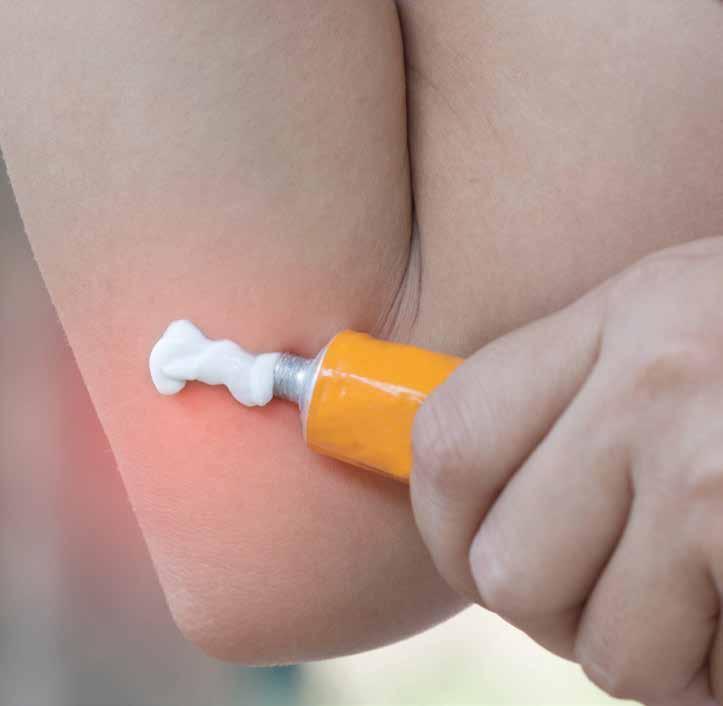
7 minute read
Adult Incontinence
Urinary Incontinence (UI) can have a hugely negative impact on a person’s quality of life, mood and confidence with some sufferers becoming virtual prisoners in their own homes. Incontinence is a condition that most people are too embarrassed to talk about, yet one that affects one in three women and one in nine men, and costs the HSE ¤100 million every year. Prevalence increases with age, with an estimated 46% of women and 34% of men aged 80-plus affected. What’s more concerning is that up to 80% of sufferers have never sought medical advice and 35% view it as simply part of the ageing process. In most cases these conditions can be easily treated or significantly improved via straightforward interventions. The local pharmacy has the advantage of being a familiar environment but one with experienced and specially trained staff whom customers trust.
WHAT IS INCONTINENCE?
Urinary incontinence is loss of control of the bladder. It can affect anyone, regardless of age. It is a condition which ranges from mild to uncontrollable and embarrassing wetting. Incontinence can often be caused by an illness, such as a urinary tract infection, and often when the infection gets better the incontinence improves. Bladder control problems have a significant effect on the quality of life of sufferers on a physical, emotional and social level. Continence is a necessity for comfortable social adjustment and conversely, urinary incontinence frequently causes profound psychological and social consequences and restricts social activities, causing sexual issues, lack of sleep due to nocturia, constipation from limiting fluid intake and falls and fractures in older people who have to rush to the toilet.
Urinary incontinence can occur when the normal process of storing and passing urine is disrupted. This can happen for a number of reasons, with certain factors increasing the likelihood of incontinence developing; advancing age is the biggest risk factor. Stress incontinence occurs when the pressure inside the bladder as it fills becomes greater than the strength of the urethra to stay closed. Additional pressure to the bladder such laughing or sneezing can then cause urine to leak. Weak or damaged pelvic floor muscles or an inadequate urethral sphincter can result in the urethra opening when it shouldn’t. These problems can be caused by:
Damage during childbirth, particularly a vaginal delivery.
Increased pressure on the abdomen, for example during pregnancy or if obese.
Surgical damage to the bladder or nearby area caused, for example, during a hysterectomy or removal of the prostate gland in men (prostatectomy). Birth defects such as a defective bladder or sphincter. Menopause, where the reduction in oestrogen results in the bladder becoming lax. Some medicines.
Urge incontinence is the urgent and frequent need to pass urine, which can be caused by a problem with the detrusor muscles in the walls of the bladder. These muscles relax to allow the bladder to fill with urine and contract when going to the toilet to let urine out. If these muscles contract too often then this creates an urgent need to go to the toilet – this is known as an overactive bladder.
Overflow incontinence (also called chronic urinary retention) is often caused by a blockage or obstruction of the bladder. The bladder fills as normal but cannot empty completely because of an obstruction causing pressure to build up behind it, causing leaking around the blockage. An obstruction can be the result of an enlarged prostate gland in men, bladder stones and constipation. Total incontinence occurs when the bladder cannot store any urine at all. This results in large amounts of urine being passed constantly or passed occasionally with frequent leaking. It can be caused by birth defects, spinal cord injury and bladder fistulas.
ASSISTING AND ADVISING
Since urinary incontinence is a very common problem, pharmacists and their teams have many opportunities to support and help their customers.
Consider moving to the consultation room starting any conversation with “we have a more private area for consultations, would this be preferable?” If an individual raises their incontinence with you, then acknowledge that this is a difficult subject for them but avoid telling them how they should feel. Consider asking open questions to allow the patient to tell you more about what is happening to them, how they feel and what they are doing to manage the issue themselves. Even though incontinence has a significant impact on people’s lives, many sufferers write it off as getting older. It can be a difficult topic to raise and yet there is much that can be done to manage the condition.
TREATMENTS
Lifestyle Advice
Frequent contraction of the detrusor muscles can be caused by:
Drinking too much alcohol or caffeine.
Poor fluid intake, which causes strong, concentrated urine to collect, irritating the bladder.
Constipation.
Conditions such as urinary tract infections (UTIs) and bladder tumours.
Incontinence Products
While incontinence products aren’t a treatment for urinary incontinence, they are useful for managing the condition while a person is waiting to be assessed or for treatment to take effect.
Absorbent products, such as incontinence pants or pads. Liners, pads, disposable underwear, and reusable underwear absorb moisture. Products made for incontinence control catch the leaks and pull moisture away from the skin. That allows sufferers to go longer between changes. Many disposable pads, liners, and undergarments have a waterproof backing. This helps prevent overflow from reaching clothes.
W W H A M
Who? Anyone, regardless of age Women are more prone to stress incontinence than men.
What are the symptoms? Depends on the type of incontinence, but generally wetting oneself or dribbling.
How long have they had the symptoms? Medical advice should be sought when symptoms present.
Action already taken? Lifestyle changes or pelvic exercises may help.
How often should I use Stérimar?
We recommend using Stérimar Isotonic and Stérimar Baby two to six times a day (or more) in each nostril for as long as you need it or as long as and as often as your doctor recommends. Stérimar Hypertonic is recommended for a short period. Use two to four times a day in each nostril for light congestion and up to six times a day for severe congestion.
Can Stérimar be used with other medication?
Yes. Stérimar is drug-free and doesn’t contain preservatives so there is no known risk of interaction with any other medication. However, in all cases it is best to check with your doctor.
Am I likely to experience any irritation from using Stérimar?
Stérimar Isotonic and Stérimar Baby are purified sea water solutions with the same concentration of salts as the cells in the human body. As such, irritation is highly unlikely. Stérimar Hypertonic has a higher salt content than Stérimar Isotonic but the solution is still less salty than sea water. A sensation of dryness may occur and should disappear within a few days. Always follow instructions and/or doctor’s recommendations.
Can I use Stérimar if I am pregnant, diabetic or suffer from high blood pressure?
Yes, Stérimar is completely safe to use with these conditions, but it is always a good idea to check with your doctor.
Can I use Stérimar for my three year old?
Yes, Stérimar Isotonic is suitable for the whole of the family, even babies from 3 months old. Stérimar Hypertonic is suitable for all adults and children over three years of age and Stérimar Baby can be used with babies from birth to 3 years old.
Is the nozzle safe to use?
Yes. The Stérimar nozzle has been specifically designed to fit any shape and size of nostrils.
Stérimar Baby has a specific nozzle with a protective flange. The nozzle cannot be pushed too far into the nose to avoid any risks of injury.
How long will Stérimar keep?
Stérimar products can be kept for a maximum of three years after manufacture or until all solution has been used. The expiry date can be found at the bottom of the can and carton. Each dose of Stérimar delivered is aseptic. The valve on top of the can prevents air from entering. Also, because the solution is kept in a sterilised pouch it never comes into contact with either the aluminium can or the non-flammable nitrogen gas within.
Why is it important to clean the nozzle after each use?

You must clean the nozzle in soapy water to remove any microorganisms left after use to help avoid any cross-contamination.
What does micro-diffusion mean?
The unique Stérimar micro-diffusion system produces a fine spray of sea water. As the droplets produced by Stérimar are microfine, they remain in contact with the walls of the nasal passages for longer, making Stérimar even more effective.
Why are the copper and manganese in Stérimar Hypertonic important?
Copper and manganese are found in very small amounts in the human body. They stimulate the body’s self defense mechanisms and help keep it healthy.










